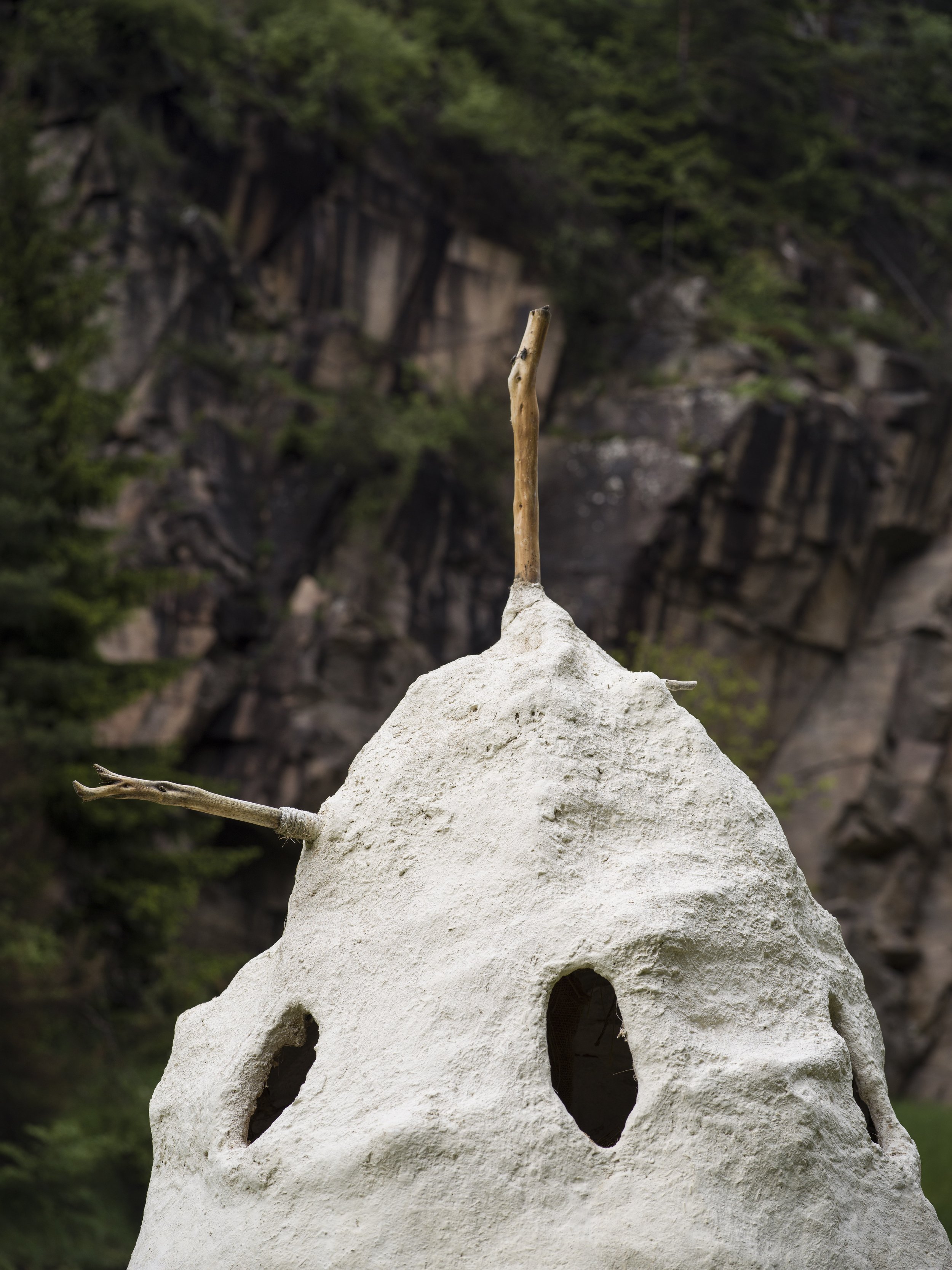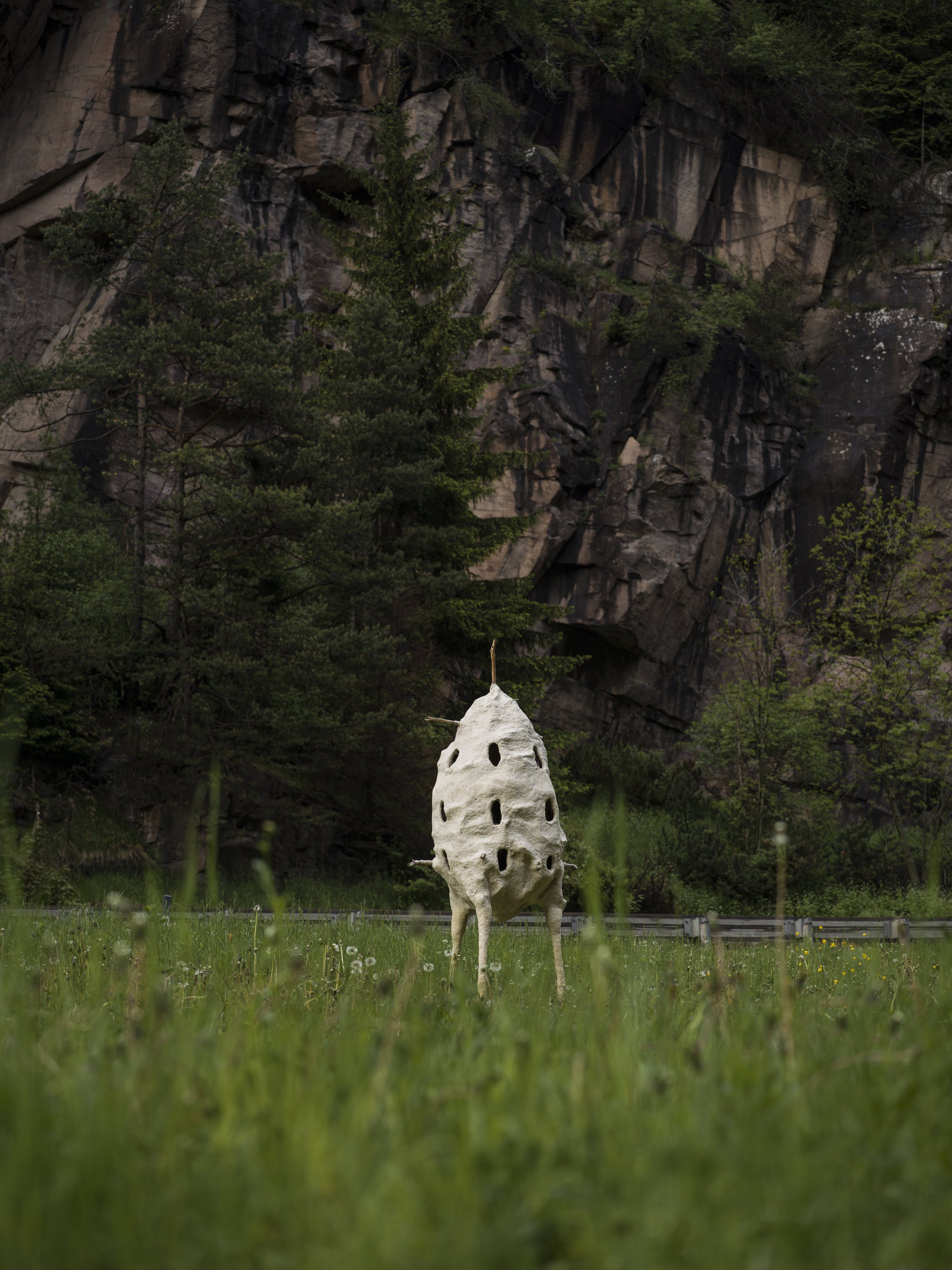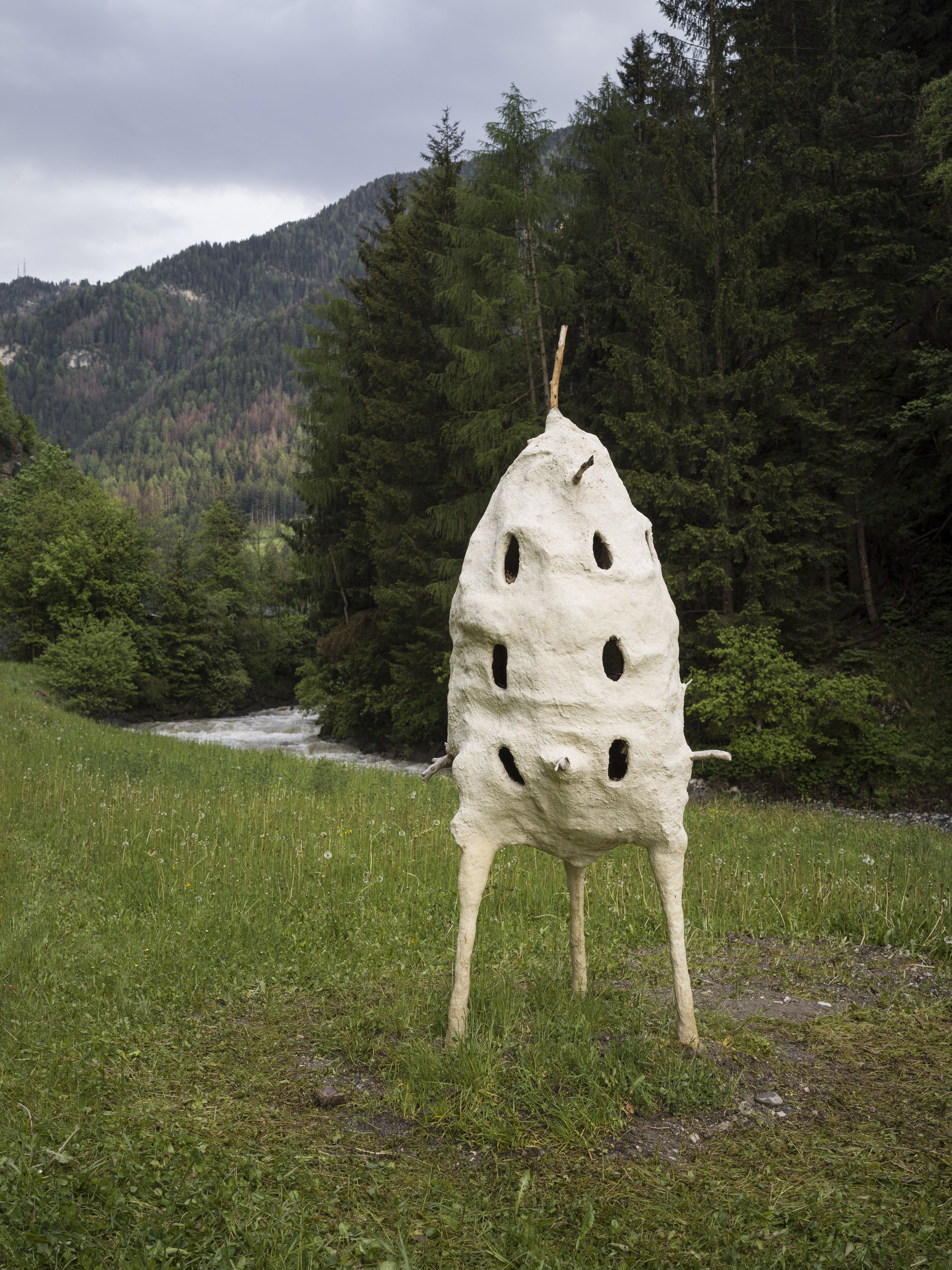
Alex Ayed, Untitled (Beit el hmam II), 2023. Clay, Olive Wood, Hay, Steel, Limewash. Courtesy of the Artist and ZERO ..., Milan and Galerie Balice Hertling, Paris. Photos by Tiberio Sorvillo



Alex Ayed, Untitled (Beit el hmam II), 2023. Clay, Olive Wood, Hay, Steel, Limewash. Courtesy of the Artist and ZERO ..., Milan and Galerie Balice Hertling, Paris. Photo by Tiberio Sorvillo
Alex Ayed
b. 1989 Strasburg, France
EN The Franco-Tunisian artist Alex Ayed currently lives and works at sea. His life embodies his way of understanding art, an itinerant practice that roots the conception of the work of art as much as possible in the territory in which it intervenes, with the aim of weaving new stories into the network of narratives already present. His works often give rise to unpredictable situations, beyond the artist’s control, such as Transumanza (2021), the title of which refers to the annual pilgrimage of shepherds, as practised in the Mediterranean for thousands of years.Prior to the opening of the exhibition, the gallery spaces hosted a flock of goatsand chickens that interacted with works designed for them – such as birdfeeders and hay objects – leaving traces of their passage in the space once opened. This lyrical and situationist approach to art is also to be found inUntitled (Beit elhmam), installed forThe Parliament of Marmotsin a grassy clearing at the edge of the highway near Pontives. The imposing sculpture, more than two metres high,is a dovecote made of olive wood, clay and straw and then covered with lime, in keeping with traditional North-African techniques. Traditionally, they were quitecommon in cities throughout the Mediterranean as well as in various parts of theworld. The most interesting aspect for Ayed is that their nature is ambiguous. Built by humans to be inhabited by turtle doves, a seemingly caring gesture but at thesame time pretentious, for however hospitable they might be, they convey the idea of domestication and a relationship of dominance. Ayed thus adopts the pigeonhouse from a metaphysical perspective, as one of the few spaces left within the confines of human settlements intended to accommodate the presence of animals. An encounter that in the artist’s vision confers great spiritual power to a space.
IT Attualmente l’artista franco-tunisino Alex Ayed vive e lavora in mare.La sua vita incarna il suo modo di intendere l’arte, una pratica itinerante che radica il più possibile la concezione dell’opera d’arte al territorio in cui interviene, con l’obiettivo di intrecciare nuove storie alla rete di narrazioni già presente. Le sue opere danno spesso luogo a situazioni imprevedibili, fuori dal controllo dell’artista, come ad esempio Transumanza(2021), il cui titolo fa riferimento all’annuale pellegrinaggio dei pastori praticato nel Mediterraneo da millenni. Prima dell’apertura della mostra gli spazi della galleria hannoospitato un gregge di capre e delle galline che hanno interagito con opere pensate per loro – come mangiatoie per becchime e oggetti porta fieno – lasciando letracce del loro passaggio nello spazio una volta aperto. Questo approccio lirico e situazionistico all’arte è presente inUntitled (Beit el hmam), installata per The Parliament of Marmots in uno spiazzo erboso ai margini della strada statale nei pressi di Pontives. L’imponente scultura alta più di due metri è una colombaia realizzata in legno d’ulivo, argilla, paglia e ricoperta di calce, secondo le tecniche tradizionali del Nord Africa. Tradizionalmente erano piuttosto comuni nelle città, in tutto il Mediterraneo ma anche in varie parti del mondo. L’aspetto più interessante per Ayed è la loro natura è ambigua. Costruite dall’essere umano perché vengano abitate dalle tortore, un gesto apparentemente premuroso ma allo stesso tempo pretenzioso, per quanto ospitali trasmettono l’idea di addomesticamento e di rapporto di dominanza. Ayed adotta la piccionaia in una prospettiva metafisica, come uno dei pochi spazi rimasti all’interno dei confini degli insediamenti umani destinati a ospitare la presenza di animali. Un incontro che nella visione dell’artista conferisce un grande potere spirituale a uno spazio.
DE Der französisch-tunesische Künstler Alex Ayed lebt und arbeitet derzeitauf See. Sein Leben verkörpert seine Art, Kunst zu verstehen, nämlich als eine nomadische Praxis, welche die Idee des Kunstwerks so weit wie möglich mit dem Gebiet verwurzelt, in dem es sich bewegt, um neue Geschichten in das Netzder bereits vorhandenen Erzählungen zu weben. Seine Werke führen oft zu unvorhersehbaren Situationen, die sich der Kontrolle des Künstlers entziehen, wie z. B.Transumanza(2021), dessen Titel sich auf die seit Jahrtausenden imMittelmeerraum praktizierte jährliche Wanderung der Hirt*innen und ihrer Tiere bezieht. Vor der Eröffnung der Ausstellung beherbergten die Galerieräume eineHerde von Ziegen und Hühnern, die mit den für sie geschaffenen Werken - wie Vogelfutterhäuschen und Heuobjekten - interagierten und sichtbare Spuren ihresAufenthalts im Raum hinterließen, sobald dieser für das Publikum geöffnet wurde.Diese lyrische und situationistische Herangehensweise an die Kunst findet sichauch in Untitled (Beit el hmam)wieder, das fürThe Parliament of Marmotsauf einer grasbewachsenen Lichtung am Rande der Staatsstraße bei Pontives aufgestellt wurde. Bei der imposanten, mehr als zwei Meter hohen Skulptur handelt es sich um einen Taubenschlag aus Olivenholz, Lehm und Stroh, der nach traditioneller nordafrikanischer Technik mit Kalk überzogen wurde. Solche Taubenhäuser waren früher in den Städten des Mittelmeerraums und in verschiedenen Teilender Welt weit verbreitet. Der interessanteste Aspekt für Ayed ist, dass ihre Naturzweideutig ist. Sie wurden von Menschen gebaut, um von Tauben bewohnt zu werden, eine scheinbar fürsorgliche Geste, die aber gleichzeitig auch anmaßend ist, denn wie gastfreundlich sie auch sein mögen, sie vermitteln die Vorstellung von Domestizierung und einer Beziehung der Dominanz. Ayed betrachtet dasTaubenhaus aus einer metaphysischen Perspektive, als einen der wenigen Räume, die innerhalb der Grenzen der menschlichen Siedlungen übrig geblieben sind, um die Anwesenheit von Tieren zu ermöglichen. Eine Begegnung, die in der Vision desKünstlers unserem Lebensraum eine große spirituelle Kraft verleiht.
LA Al mumënt viv y lëura l artist franzesc-tunisin Alex Ayed sun l mer.Si vita ie l’esprescion de coche ël ntënd l’ert, na pratica che va for inant chenravisea plu che la va l cunzet dl’opra d’ert ala tiera ulache la nasc, cun lubietif de lië stories nueves ala rë de cunties bele prejëntes. Te si opres vënielsuvënz a se l dé situazions nia da udëi danora, ora dl cuntrol dl artist, cocheper ejëmplTransumanza(2021), ulache l titul fej referimënt al pelegrinaje chei pastri fej uni ann tl Mediteran da milesc de ani. Dan la giaurida dla mostra àla lerch tla galaria tëut su n pastrëc de cëures y n valguna gialines che se à metùn relazion cun l’opres pensedes per ëiles – coche la cianeves – lascian i sëniesde si passaje tla lerch do che la ie unida giaurida. Chësc ti jì permez lirich yaldò dla situazion al’ert ie prejënt teUntitled (Beit el hmam), l’opra instaledaperThe Parliament of Marmotste n tòch de ierba sun l ëur dla streda stateladaujin a Pontives. La scultura mposanta auta plu de doi metri ie n banch dalatupes fata de lën de ulif, arjila, stram y curida ju cun ciauc, aldò dla tecnichestradiziuneles dl Africa dl Nord. Aldò dla tradizion fovi bëndebò suvënz da udëi tla ziteies te dut l Mediteran, ma nce te d’autra pertes dl mond. L aspet plumpurtant per Ayed ie si natura da ntënder te doi manieres. Fac su dala personesacioche l vive laite la tupes, n cumpurtamënt che semea festidià, ma tl medemmumënt nce da uem y che per tant che n se dà da fé dà inant l’idea de unì zartieiy de na relazion de duminazion. Ayed tol ca l banch dala tupes te na perspetivametafisica, coche un di puec posć restei dedite dai cunfins di nridlamënc y udùdant per tò su tieres. Na ancunteda che l artist vëija coche n ti sëurandé n granpudëi spirituel a n post.